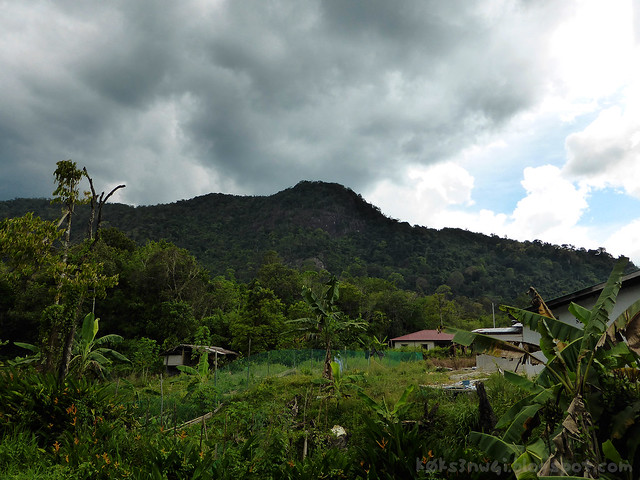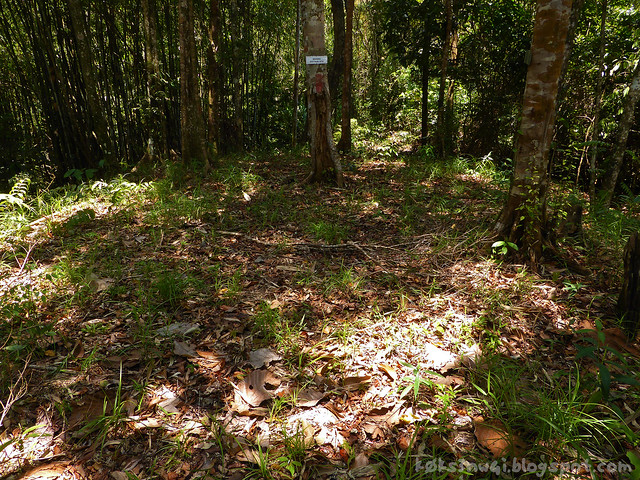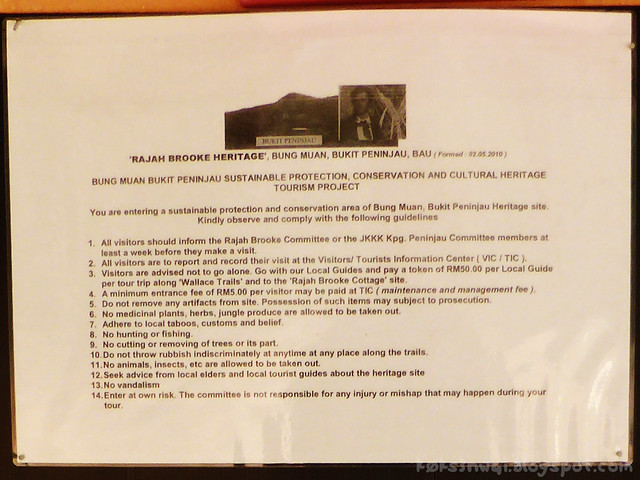"Professor Johnston often said that if you didn't know history, you didn't know anything. You were a leaf that didn't know it was part of a tree."
Timeline (1999) by Michael Crichton
 |
| Picture of Bukit Serumbu from Kampung Peninjau, after I descended from it. |
Last month on April 13, I climbed Bukit Serumbu near the town of Siniawan in Bau. The local Bidayuhs call it Bung Muan while Sarawak's first White Rajah, James Brooke, have used it as a lookout point and have built a cottage at the 424 metres height of the mountain - giving the place its third name, Peninjau (which is the Malay word for "observer" or "surveyor"). Indeed, the modern villages that now fringe the foothills of Bukit Serumbu are called Kampung Peninjau Lama and Kampung Peninjau Baru.
That cottage that Brooke erected came to be known today as the Brooke Cottage and it was said that the original White Rajah have entertained guests there, including a certain British naturalist who would be later known (and then mostly forgotten) as the co-originator of the theory of evolution through natural selection, Alfred Russel Wallace. Here is an excerpt from Wallace's The Malay Archipelago (1869),
"On reaching Sarawak early in December, I found there would not be an opportunity of returning to Singapore until the latter end of January. I therefore accepted Sir James Brooke's invitation to spend a week with him and Mr. St. John at his cottage on Peninjauh. This is a very steep pyramidal mountain of crystalline basaltic rock, about a thousand feet high, and covered with luxuriant forest. There are three Dyak villages upon it, and on a little platform near the summit is the rude wooden lodge where the English Rajah was accustomed to go for relaxation and cool fresh air. It is only twenty miles up the river, but the road up the mountain is a succession of ladders on the face of precipices, bamboo bridges over gullies and chasms, and slippery paths over rocks and tree-trunks and huge boulders as big as houses. A cool spring under an overhanging rock just below the cottage furnished us with refreshing baths and delicious drinking water, and the Dyaks brought us daily heaped-up baskets of Mangosteens and Lansats, two of the most delicious of the subacid tropical fruits. We returned to Sarawak for Christmas (the second I had spent with Sir James Brooke), when all the Europeans both in the town and from the out-stations enjoyed the hospitality of the Rajah, who possessed in a pre-eminent degree the art of making every one around him comfortable and happy."
Wallace apparently enjoyed Brooke's hospitality and Sarawak so much that he would end up sticking around for 14 months, longer than any other place he visited in this region. In fact, Wallace's first published paper mentioning evolution, On the Law which has Regulated the Introduction of New Species (1855), was written when he was in Sarawak and the natural law he proposed in it would come to be referred to vernacularly as the "Sarawak Law". This foreshadowed the joint presentation of Darwin and Wallace's works three years later in 1858 in front of the Linnean Society of London, marking the official birth of evolution as a serious scientific theory.
I myself have looked for the site of Brooke Cottage in my visit there but that endeavour was met with disappointment when I found out that what remains of it was a nondescript clearing, completely unremarkable except for a small sign nailed to a tree that proclaims it to be the famous "Brooke Cottage site".
 |
| The Brooke Cottage site. |
The site was apparently lost to obscurity until its rediscovery in 1988 by the State Museum Department thanks to efforts by renowned zoologist, biologist and former Universiti Malaya lecturer Gathorne Gathorne-Hardy, the 5th Earl of Cranbrook (otherwise known as Datuk Seri Lord Cranbrook) who said,
"The first one I discovered was Rajah Brooke’s bungalow in Matang. I have been looking for this one (Brooke’s Cottage in Bung Muan, Bukit Peninjau) for a long time. This had led me to visit Kampung Peninjau and from the visit, I discovered that the villagers here knew the way to the site."
Anyway, given its story, Bukit Serumbu should rightly be recognised as a location of great historical import to both scientific inquiry and the people of Sarawak, and restoration efforts were finally announced in March 2012, to begin in earnest in June. According to project consultant Rangen Sangum, the first phase of the project will involve the construction of tourist information centre, car park, access road, Wallace Point and Brooke observation platform. It was estimated to cost RM1 million with a projected duration of 9 months to completion.
Now, before I climbed Bukit Serumbu on the 13th of April 2014, I visited Kampung Peninjau after my Mount Singai trek and found a wooden hut there that stands in for the tourist information centre. There was a laminated and yellowed notice pinned on its front,
 |
| Rules, schmules. |
I followed the rules. I called up the contacts given in the week before I intended to make my climb, but found that most of the numbers were no longer operational. When I finally managed to get through to one of them, he said that he was no longer part of the committee and gave me his brother's digits, asking me to contact him instead. The bloke I finally talked to sounded clueless, but he had no objections to me making my climb.
When I turned up on the day of my trek, there was no one inside the
The second phase of the restoration project expected to cost between RM2 million and RM3 million would involve the construction of a ceremonial house, longhouses, an outdoor bath, and replica of the Brooke Cottage itself based on site survey data and written descriptions of the structure. As I've mentioned earlier, the only thing they have to show for this is a piece of paper wrapped in clear plastic and nailed to a tree marking the Brooke Cottage site.
I want to know who won the tender to run this restoration project. I want to know if funds were ever infused into it and if it was, where did all the money go?
 |
| According to this sign, the project is an initiative of the Sarawak Ministry of Tourism and Heritage, Universiti Malaysia Sarawak (UNIMAS), the Rajah Brooke Heritage Committee of Bung Muan, Peninjau and a 4th body that had been painted over. Funding was suppose to come from the Malaysian Ministry of Tourism and the Global Environment Facility (GEF) Small Grants Programme. |
I got a feeling that before long, the Wallace Trail and Brooke Cottage will be lost to the murky currents of time again.
RELATED POST: Retracing Wallace's Trail at Bukit Serumbu
Unhappy fan of Wallace,
k0k s3n w4i


5 comments:
I humbly suggest you direct all enquiries to Encik Abdul Taib Mahmud. Maybe he had forgotten all about it given the nature of his work?
A very expensive set of signs indeed!
The useful work on the paths (and on 'facilities' for camping at the rock) was done last year for biological surveying by UNIMAS, and the sponsor painted out (since September) was 'Persatuan A.S.A.I. Serembu'
For the cottage's first rediscovery, see - http://www.scribd.com/doc/17726505/Where-Wallace-Trod
For masses more history see - http://www.scribd.com/doc/76302631/Serembu-settlements-from-1839
Darshan: I doubt Taib has a hand in this. In fact, I don't think he is even aware of this project in the first place.
Martin Laverty: Thanks for all the extra information. How are you involved in all this?
My name is Alex Sayok. I am from The Institute of Biodiversity and Environmental Conservation, Universiti Malaysia Sarawak. I am the one who assisted the local community in securing USD50,000 funds from the Global Environment Center, UNDP. In return, UNIMAS was involved in the biodiversity study in 2012 and got RM50,000 with rest for the community to take for various components within the project such as trail improvements, training for tourism, awareness programmes, and tourism information office which you seen. There was also a fund from the government under the tourism ministry of RM1.7 million initially but was cut back many times to RM700,000, and this was stuck somewhere until now and probably will never be given. Let's here the next announce when it's close to the next state election and GE14.
Our study results had been shared in many fora including The Wallace Conference in Nov 2013. I am in the process of writing the final report and a tablebook for the project under the RM50,000 share we got. Hope that you and others will be clear on how the fund are spent.
This is a HUGELY important site, and could be a serious draw for tourism if handled correctly.
Post a Comment